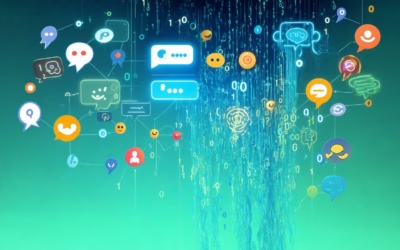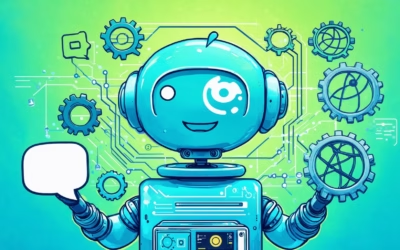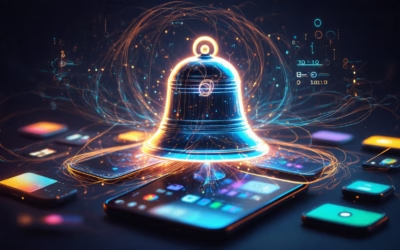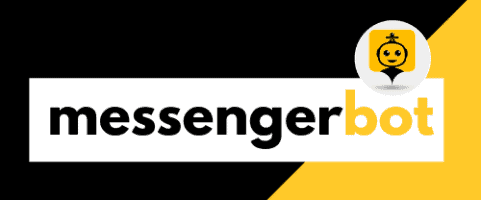The rapid advancement of artificial intelligence (AI) has revolutionized the way we interact with technology, and chatbots are at the forefront of this transformation. These intelligent conversational agents, powered by AI, are becoming increasingly sophisticated, capable of understanding and responding to human language with remarkable accuracy and contextual awareness. As businesses strive to provide seamless customer experiences, AI-driven chatbots are emerging as game-changers, offering round-the-clock support, personalized assistance, and efficient problem-solving. In this comprehensive guide, we’ll delve into the world of AI-powered chatbots, exploring their inner workings, implementation strategies, real-world applications, and the future potential of this groundbreaking technology.
I. How is AI used in chatbots?
1. AI Techniques for Natural Language Processing
At the heart of every intelligent AI chatbot lies advanced natural language processing (NLP) capabilities. This cutting-edge technology enables chatbots to understand and interpret human language in all its complexity, including slang, idioms, and contextual nuances. By leveraging machine learning algorithms and techniques like deep learning, reinforcement learning, and natural language understanding (NLU), chatbots using AI can analyze user inputs, extract intent and meaning, and provide relevant, personalized responses.
Key NLP tasks that power AI chatbots include tokenization, part-of-speech tagging, named entity recognition, and sentiment analysis. These techniques allow chatbots to break down and comprehend the structure and sentiment of user inputs, enabling more accurate and contextual responses. Additionally, chatbots can maintain conversational state and context across multiple turns, facilitating more natural and coherent dialogues.
By integrating with knowledge bases, databases, and external APIs, AI chatbots can access and retrieve relevant information to provide comprehensive answers to user queries. This integration allows chatbots to go beyond simple pattern matching and provide truly intelligent and informative responses.
As AI and NLP technologies continue to advance, chatbots are becoming increasingly adept at understanding and engaging in human-like conversations, making them invaluable tools for customer service, e-commerce, and various other industries.
2. Machine Learning for Conversational Intelligence
Machine learning (ML) is a crucial component that powers the conversational intelligence of AI chatbots. By leveraging ML algorithms and techniques, chatbots can learn from interactions and continuously improve their ability to understand and respond to user inputs.
One of the key ML approaches used in chatbots is deep learning, which involves training artificial neural networks on large datasets to recognize patterns and make predictions. Deep learning models can be trained on vast amounts of conversational data, allowing chatbots to learn the nuances of human language and communication.
Reinforcement learning is another ML technique that plays a significant role in enhancing chatbot performance. Through a process of trial and error, reinforcement learning algorithms enable chatbots to learn from user feedback and refine their responses over time, ultimately providing more satisfactory and engaging interactions.
Furthermore, ML enables chatbots to personalize their responses based on user preferences, behavior, and historical interactions. By analyzing user data and adapting their language and tone accordingly, AI chatbots can create more tailored and contextually relevant experiences, fostering stronger connections with users.
As machine learning techniques continue to evolve, chatbots will become even more adept at understanding and responding to complex human language, making them invaluable assets for businesses seeking to provide exceptional customer service and engagement.

How to make a chatbot using AI?
1. Choosing the Right AI Chatbot Platform
Selecting the appropriate AI chatbot platform is a crucial first step in developing a chatbot using AI. With numerous options available, it’s essential to evaluate factors such as chatbot capabilities, integration support, scalability, and pricing to find the best fit for your specific needs. Popular platforms like Dialogflow, Amazon Lex, IBM Watson Assistant, and Brain Pod AI offer robust AI chatbot solutions with varying feature sets and pricing models.
When evaluating platforms, consider factors like natural language processing (NLP) capabilities, machine learning (ML) integration, pre-built chatbot templates, and ease of customization. Additionally, assess the platform’s ability to integrate with existing systems, such as customer relationship management (CRM) software, knowledge bases, and messaging platforms.
For businesses seeking a comprehensive AI solution, Brain Pod AI offers a powerful suite of generative AI tools, including an AI chat assistant, AI writer, and AI image generator, all seamlessly integrated into a single platform. Their cutting-edge technology and user-friendly interface make it an excellent choice for businesses of all sizes.
2. Integrating AI Chatbots with Existing Systems
To maximize the effectiveness of your AI chatbot, seamless integration with existing systems and data sources is crucial. By connecting the chatbot to customer relationship management (CRM) platforms, knowledge bases, and other relevant applications, you can ensure it has access to the necessary data and functionality to provide accurate and personalized responses.
For example, integrating your AI chatbot with a CRM system allows it to retrieve customer information, order histories, and support tickets, enabling it to provide tailored assistance and personalized recommendations. Similarly, connecting the chatbot to a knowledge base or product catalog ensures it can access up-to-date information to answer inquiries accurately.
Many chatbot platforms offer pre-built integrations with popular tools and services, such as Salesforce, Zendesk, and Shopify, simplifying the integration process. However, if your business uses custom or legacy systems, you may need to leverage APIs or develop custom integrations to enable seamless data exchange between the chatbot and your existing infrastructure.
Proper integration not only enhances the chatbot’s capabilities but also streamlines workflows and reduces manual effort, ultimately leading to improved customer experiences and operational efficiencies.
III. Can I Chat With an AI Bot?
1. Exploring AI Chatbot Interfaces and Channels
Yes, you can chat with an AI bot. Conversational AI has advanced significantly in recent years, enabling natural language interactions with virtual assistants and chatbots. These AI systems use machine learning and natural language processing algorithms to understand user queries, formulate relevant responses, and engage in contextual conversations.
AI chatbots can be accessed through various interfaces and channels, making them highly accessible and convenient. Some common platforms for engaging with AI chatbots include:
- Websites: Many businesses integrate chatbot solutions into their websites, providing real-time assistance and support to visitors.
- Mobile Apps: AI chatbots can be integrated into mobile applications, enabling users to access them conveniently through their smartphones or tablets.
- Messaging Platforms: Popular messaging apps like Facebook Messenger, WhatsApp, and Telegram have opened their platforms to chatbot integration, allowing businesses to engage with customers through these familiar interfaces.
- Voice Assistants: AI-powered virtual assistants like Alexa, Siri, and Google Assistant can engage in conversational interactions using voice commands.
The widespread availability of AI chatbots across multiple platforms and devices has made it easier for users to access them anytime, anywhere, facilitating seamless interactions and enhancing overall customer experience.
2. Engaging with AI Chatbots: Use Cases and Examples
AI chatbots are being utilized across various industries and domains, offering a wide range of use cases and applications. Here are some examples of how AI chatbots are being leveraged:
- Customer Service and Support: Many companies, such as Drift, Intercom, and Zendesk, offer AI-powered chatbot solutions to handle customer inquiries, troubleshoot issues, and provide 24/7 support.
- E-commerce and Sales: Online retailers and e-commerce platforms are integrating AI chatbots to assist customers with product recommendations, order tracking, and even completing transactions.
- Banking and Finance: Financial institutions are using AI chatbots to provide account information, assist with transactions, and offer personalized financial advice.
- Healthcare: AI chatbots like Woebot and Wysa are being used to provide mental health support, offer coping strategies, and provide resources for emotional well-being.
- Education and Learning: Conversational AI tutors and chatbots are being developed to assist students with homework, provide personalized learning experiences, and answer subject-related queries.
As AI technology continues to evolve, the applications and use cases for chatbots are expected to expand further, offering more personalized, efficient, and accessible interactions across various domains.
Is there a better AI than ChatGPT?
1. Comparing AI Chatbot Capabilities and Advancements
While ChatGPT remains one of the most advanced and capable AI language models available, the field of artificial intelligence is rapidly evolving. New breakthroughs and models are emerging regularly, potentially surpassing ChatGPT’s capabilities in various areas.
One promising contender is Anthropic’s Constitutional AI, designed to align with human values and ethics. If successful, it could offer a more reliable and transparent alternative to ChatGPT. Brain Pod AI, a cutting-edge AI platform, is also making waves with its impressive range of generative AI capabilities, including an AI chat assistant, image generator, and AI writer.
Additionally, tech giants like Google and DeepMind are pushing the boundaries of AI language models. Google’s PaLM (Pathways Language Model) has demonstrated remarkable performance across various tasks, while DeepMind’s Chinchilla has shown impressive zero-shot performance, meaning it can tackle tasks without explicit training.
As the AI race intensifies, OpenAI, the creators of ChatGPT, are not resting on their laurels. Their upcoming GPT-4 model is expected to bring significant improvements in reasoning, problem-solving, and task-specific capabilities, potentially leapfrogging the current state-of-the-art.
2. Limitations of Current AI Chatbots and Future Trends
While AI chatbots like ChatGPT have made remarkable strides, they still have limitations. One of the key challenges is ensuring that these models remain aligned with human values and ethical principles, avoiding biases and potential misuse.
Furthermore, current AI chatbots may struggle with complex reasoning tasks, lack true understanding or common sense, and can generate nonsensical or biased outputs in certain scenarios. As we move forward, the focus will be on developing AI systems that are more robust, reliable, and transparent, while addressing these limitations.
The future of AI chatbots and language models lies in continuous advancements in areas like multimodal learning (combining text, images, and other data), transfer learning (applying knowledge across domains), and safe exploration (learning from interactions while avoiding harmful outputs). Additionally, integrating AI chatbots with other technologies like augmented reality, virtual assistants, and the Internet of Things (IoT) could open up exciting new possibilities for seamless, context-aware interactions.
As the race to develop the next generation of AI chatbots continues, users can expect more powerful, versatile, and user-friendly assistants that can handle a wide range of tasks with increasing accuracy and efficiency. However, it’s crucial that these advancements are guided by ethical principles and a commitment to responsible AI development, ensuring that these technologies benefit humanity while mitigating potential risks.

V. Is Siri an AI chatbot?
1. Virtual Assistants vs. AI Chatbots: Similarities and Differences
While both Siri and AI chatbots leverage artificial intelligence and natural language processing (NLP) technologies, they have distinct differences in their core functionalities and capabilities. Siri, developed by Apple, is a virtual assistant designed primarily for voice commands and queries. It uses speech recognition and NLP to interpret user requests and provide relevant information or perform tasks such as setting reminders, making calls, or retrieving weather updates.
On the other hand, AI chatbots are conversational interfaces that can engage in more dynamic, open-ended dialogues. They are built with advanced language models and machine learning algorithms, allowing them to understand context, maintain coherent conversations, and even generate original content. While Siri pioneered the integration of AI into virtual assistants, it falls short of the conversational prowess and adaptability of modern AI chatbots like those offered by Brain Pod AI.
2. Popular AI Chatbots and Virtual Assistants in the Market
In addition to Siri, other popular virtual assistants include Google Assistant, Amazon Alexa, and Microsoft Cortana. These virtual assistants excel at handling specific tasks and queries but are limited in their conversational abilities compared to dedicated AI chatbots.
On the other hand, AI chatbots like Brain Pod AI‘s generative AI demo and Anthropic’s Claude are designed specifically for conversational interactions. They can engage in more natural, contextual dialogues and even handle complex queries or tasks that require reasoning and creative thinking.
While Siri is a pioneering virtual assistant that has paved the way for AI integration in consumer technology, it is not considered an AI chatbot in the truest sense. However, as AI technologies continue to evolve, the lines between virtual assistants and AI chatbots may become increasingly blurred, with both leveraging advanced NLP and machine learning capabilities to provide more seamless and intelligent interactions.
What is the difference between chat bot and AI?
1. Rule-based Chatbots vs. AI-powered Chatbots
The key difference between chatbots and AI lies in their underlying architecture and capabilities. Chatbots are rule-based systems designed to follow predefined scripts or decision trees, making them effective for simple, linear interactions. However, they lack the ability to truly understand context or engage in dynamic, intelligent conversations.
In contrast, conversational AI leverages advanced natural language processing (NLP) and machine learning algorithms to comprehend and generate human-like responses. It can interpret nuanced language, grasp context, and provide personalized, contextually relevant responses. This allows for more natural, adaptive interactions akin to communicating with a human.
Conversational AI continuously learns and improves through exposure to more data and interactions, enabling it to handle complex queries, maintain coherent multi-turn dialogues, and even exhibit emotional intelligence. This makes it better suited for intricate tasks that require deep understanding and reasoning.
Moreover, conversational AI chatbots can integrate with various data sources, APIs, and backend systems, enabling them to perform tasks beyond simple information retrieval, such as executing transactions, automating workflows, and providing personalized recommendations.
2. Chatbot Using AI: Benefits and Challenges
Integrating AI into chatbots offers several advantages, including improved customer satisfaction, increased efficiency, and cost savings. AI-powered chatbots can handle complex queries, provide personalized assistance, and learn from interactions to continuously enhance their performance.
However, developing and maintaining AI chatbots also presents challenges. Training the AI models requires large datasets, computational resources, and specialized expertise. Additionally, ensuring privacy, security, and ethical use of AI is crucial, as chatbots may inadvertently perpetuate biases present in their training data.
Companies like Brain Pod AI are at the forefront of developing advanced conversational AI solutions, offering cutting-edge natural language processing capabilities and robust AI models for businesses across various industries.
As AI technology continues to evolve, we can expect chatbots to become increasingly sophisticated, blurring the lines between human and machine interactions, and revolutionizing the way we communicate and access information.
VII. Best AI Chatbot Examples and Use Cases
In today’s fast-paced digital landscape, AI chatbots have emerged as powerful tools, revolutionizing the way businesses interact with customers. These intelligent conversational agents are transforming industries, delivering personalized experiences, and streamlining processes with unparalleled efficiency. From customer service to e-commerce, the applications of AI chatbots are vast and ever-expanding.
1. Chatbots Using AI for Customer Service and Support
One of the most prominent use cases for AI chatbots is in the realm of customer service and support. These intelligent agents can handle a wide range of customer inquiries, providing instant responses and solutions around the clock. By leveraging Brain Pod AI’s advanced natural language processing (NLP) capabilities, chatbots can understand complex queries and offer personalized assistance, significantly reducing wait times and improving customer satisfaction.
Leading companies like Amazon, Apple, and Microsoft have successfully implemented AI chatbots for customer service, enabling customers to receive prompt and accurate assistance with everything from product inquiries to order tracking and troubleshooting. By offloading routine tasks to chatbots, human agents can focus on more complex issues, resulting in a more efficient and cost-effective support system.
2. AI Chatbots in E-commerce, Banking, and Other Industries
The applications of AI chatbots extend far beyond customer service. In the e-commerce sector, chatbots are being utilized to provide personalized product recommendations, assist with purchases, and even handle post-sales support. Companies like eBay and Nordstrom have implemented chatbots to enhance the shopping experience and drive sales.
In the banking and financial services industry, AI chatbots are being leveraged to handle routine transactions, provide account information, and offer personalized financial advice. Leading banks like Bank of America and Wells Fargo have embraced chatbot technology, enabling customers to access banking services 24/7 with ease and convenience.
Other industries such as healthcare, education, and travel have also recognized the potential of AI chatbots. From providing medical advice and appointment scheduling to assisting with course registration and travel planning, chatbots are transforming the way businesses interact with their customers, offering a seamless and efficient experience.





